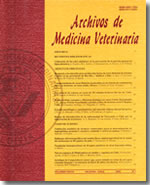Quantification of risk factors for mastitis, ovarian cyst, milk fever and ketosis (in Holstein cattle) using logistic regression in Holstein cattle
Main Article Content
Abstract
Intensive milk production methods have been related to an increase in health disorders. Milk yield improvement, either by genetics or management, is not always accompanied by a proportional increase in profits for dairy farmers. Cows with high milk yield have greater hand labour demands and a higher frequency of health disorders. The aim of this work was to asses some of the important risk factors in the incidence of mastitis, ovarian cyst, milk fever and ketosis.
Clinical cases, recorded as all or no traits, were examined using logistic regression to quantify the association between diseases and variables which might be risk factors. Odds ratios and their confidence intervals were estimated. The data set consisted of observations on 8391 Canadian Holstein cows. Potential risk factors included in the models were: parity, calving season, year of calving, days in milk, milk, fat and protein yield.
Parity was a risk factor for all diseases studied. Calving season and milk yield were significantly associated with ovarian cyst and milk fever. None of diseases was associated with fat or protein yield. Days in milk was found to be associated with ovarian cyst. However it is not clear if days in milk is a cause or an effect for ovarian cyst.

